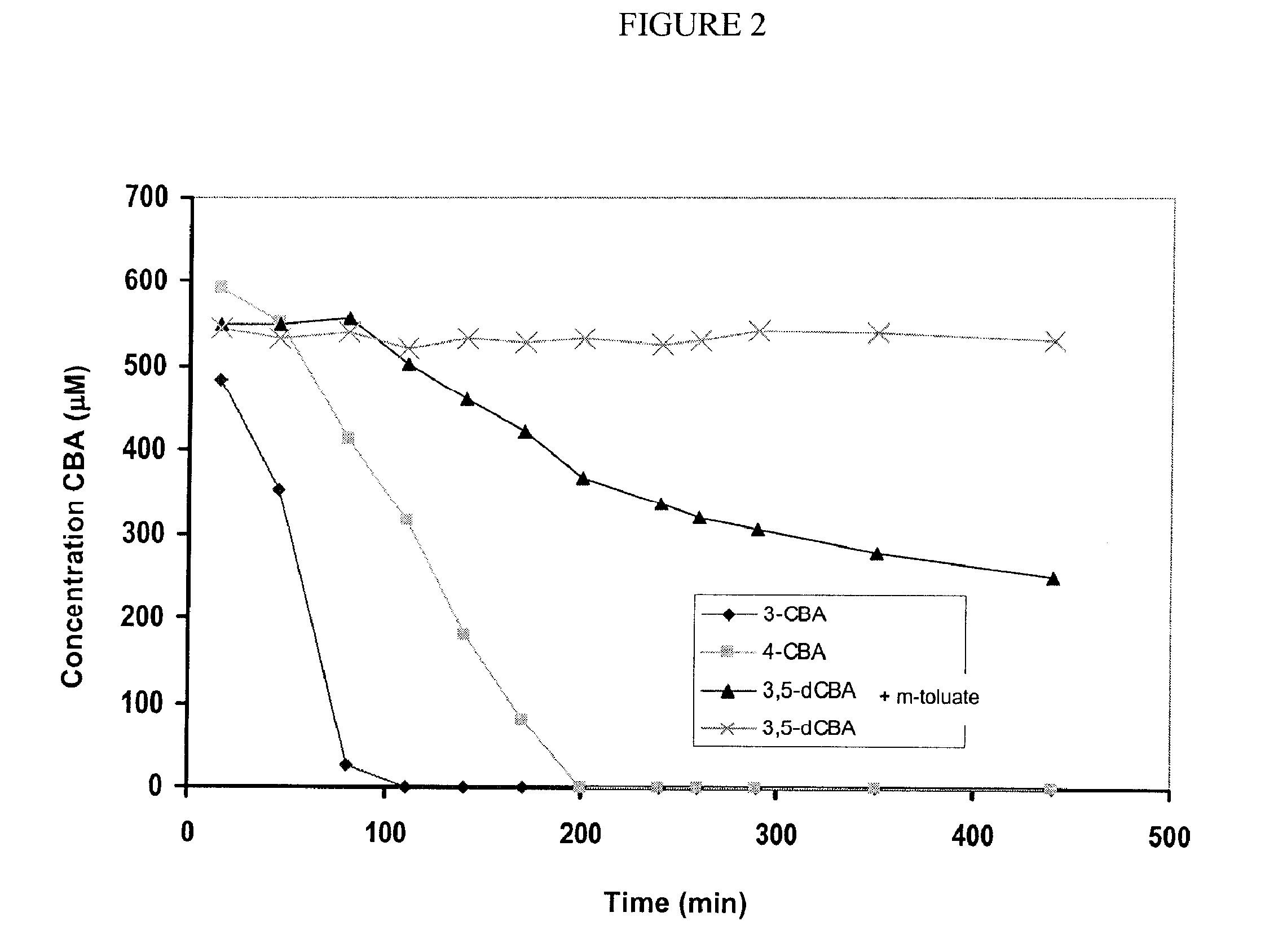PCB-degrading recombinant bacterium, product for the bioremediation and method of bioremediation
a technology of pcb-contaminated waste and recombinant bacteria, applied in the direction of biocide, plant growth regulators, solid waste disposal, etc., can solve the problems of contaminated waste, high cost of techniques, and large problems, and achieve the effect of improving the bioremediation of contaminated environmen
- Summary
- Abstract
- Description
- Claims
- Application Information
AI Technical Summary
Benefits of technology
Problems solved by technology
Method used
Image
Examples
example 1
Degradation of PCBs by Cupriavidus necator JMS34
[0051]The capability of the strain JMS34 to completely degrade or mineralize four different congeners of PCBs: two monochlorinated biphenyls, 3-CB and 4-CB, and two dichlorinated biphenyls, 3,5-dCB and 2,4′-dCB (2,4′-dichlorobenzoate), which produce as metabolic intermediates 3-CBA, 4-CBA, 3,5-dCBA and 4-CBA, respectively, was evaluated. These CBAs can be degraded by strain JMS34. Resting cells of strain JMS34, previously grown in biphenyl or a mixture of biphenyl with m-toluate (3-methylbenzoate) and concentrated 10 times, were incubated during 72 h with PCB congeners. At the end of the incubation, the remaining PCB concentration in the medium, the type and the concentration of accumulated CBA, and the concentration of released chloride were determined. The chloride release is a consequence of the deshalogenation of the initial substrate, and therefore it represents a good parameter to evaluate the degradation of chlorinated compounds...
example 2
Bioremediation of Soils Contaminated with PCBs
[0060]Diverse strategies for biorremediation of soils contaminated with PCBs have been described, from the induction of catabolic activities of the affected soil to addition of genetically modified microorganisms. In all cases relevant abiotic variable has to be controled such as amount and type of nutrients, inducing compounds, degradation promoting agents (for example, surfactants), aereation and temperature. The report by Gilbert and Crowley constitutes an example of bioremediation through the addition of a PCB-degrading bacterial strain to contaminated soils (Gilbert and Crowley 1998). A sandy soil of known physical and chemical properties was contaminated with of Aroclor 1242 (100 mg per gram of soil). Samples (20 grams) of contaminated soil were inoculated with the PCB-degrading strain Arthrobacter sp. B1B (3 ml) at a concentration of 108 cells / ml. A saline solution without cells was added to control soils. The soil moisture was ma...
example 3
Application Example
[0062]The capability of the strain JMS34 to degrade PCBs in contaminated soils was evaluated. For this purpose sterile and non-sterile microcosms were prepared and then contaminated with 3-CB, 4-CB, and 2,4′-dCB. These microcosms were inoculated with the strain JMS34 and strain LB400 to a final concentration of approximately 108 colony forming units / g of soil. These systems were incubated at 30° C. with agitation during 63 days. In addition sterile and non-sterile control microcosms without inoculum were used. The sampling took place on days 0, 35 and 63 of the incubation period. Relevant variables such as moisture and bacterial concentration in the microcosms were evaluated every 15 days during the whole period of incubation.
[0063]The samples were extracted with hexane, concentrated and dried and then dissolved in a known final volume of the same solvent. Anthracene was used as internal standard. The concentration of PCBs in the samples was determined by gas chro...
PUM
| Property | Measurement | Unit |
|---|---|---|
| time | aaaaa | aaaaa |
| volume | aaaaa | aaaaa |
| temperature | aaaaa | aaaaa |
Abstract
Description
Claims
Application Information
 Login to View More
Login to View More - R&D
- Intellectual Property
- Life Sciences
- Materials
- Tech Scout
- Unparalleled Data Quality
- Higher Quality Content
- 60% Fewer Hallucinations
Browse by: Latest US Patents, China's latest patents, Technical Efficacy Thesaurus, Application Domain, Technology Topic, Popular Technical Reports.
© 2025 PatSnap. All rights reserved.Legal|Privacy policy|Modern Slavery Act Transparency Statement|Sitemap|About US| Contact US: help@patsnap.com



